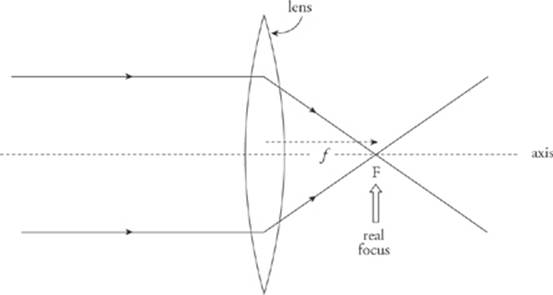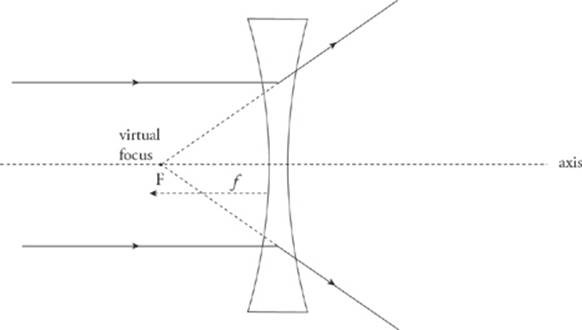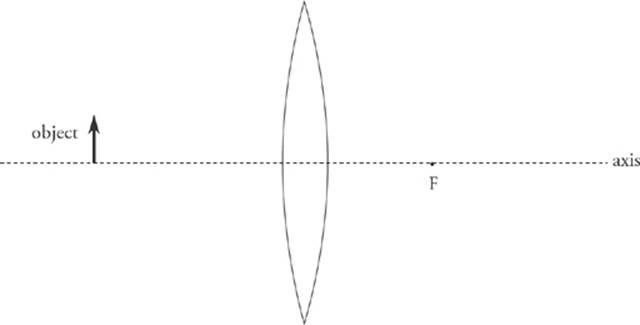SAT Physics Subject Test
Chapter 14 Optics
THIN LENSES
A lens is an optical device that forms an image by refracting light. We”ll now talk about the equations and conventions that are used to analyze images formed by the two major categories of lenses converging and diverging.
A converging lens—like the bi-convex one shown below—converges parallel paraxial rays of light to a focal point on the far side. (This lens is bi-convex; both of its faces are convex. Converging lenses all have at least one convex face.) Because light rays actually focus at F, this point is called a real focus. Its distance from the lens is the focal length, f.

A diverging lens—like the bi-concave one shown below—causes parallel paraxial rays of light to diverge away from a virtual focus, F, on the same side as the incident rays. (Diverging lenses all have at least one concave face.)

Ray Tracing for Lenses
Just as is the case with mirrors, representative rays of light can be sketched in a diagram along with the object and the lens; the point at which the reflected rays intersect (or appear to intersect) is the location of the image. The rules that govern these rays are as follows:
Converging Lenses
• An incident ray parallel to the axis is refracted through the real focus.
• Incident rays pass undeflected through the optical center, O (the central point within the lens where the axis intersects the lens).
Diverging Lenses
• An incident ray parallel to the axis is refracted away from the virtual focus.
• Incident rays pass undeflected through the optical center, O.
![]()
24. The figure below shows a converging lens and an object (denoted by the bold arrow). Use a ray diagram to locate the image of the object.

Here”s How to Crack It

![]()
![]()
25. The figure below shows a diverging lens and an object. Use a ray diagram to locate the image of the object.

Here”s How to Crack It

As we mentioned before, the nature of the image—that is, whether it”s real or virtual—is determined by the side of the lens upon which the image is formed. If the image is formed on the side of the lens that”s opposite the object, then the image is real, and if the image is formed on the same side of the lens as the object, then it”s virtual. Therefore, the image in Question 24 is real, while the image in Question 25 is virtual.
Which Side is Real?
For mirrors, the real side
(where s0 ![]() 0) is the
0) is the
same side as the object.
For lenses, the real side is
opposite the object.
![]()
Using Equations to Answer Questions About the Image
Using the notation we used for mirrors, we can summarize the equations and conventions for analyzing the images formed by lenses. Except for the reversal of the physical locations of real versus virtual images, everything else is the same.

![]()
Questions 26-29
An object of height 10 cm is placed 40 cm in front of a converging lens with a focal length of 20 cm.
26. Where”s the image?
27. Is it real or virtual?
28. Is it upright or inverted?
29. What”s the height of the image?
Here”s How to Crack It
26. With so = 40 cm and f = 20 cm, the lens equation gives us

So the image is located 40 cm from the lens, on the opposite side from the object.
27. Because si is positive, the image is real.
28. Real images are inverted.
29. The magnification is

(The fact that the magnification is negative confirms that the image is inverted.) The height of the image is
h1 = |m| • ho = 1(10 cm) = 10 cm
These results are illustrated in Question 24.
![]()
![]()
Questions 30-33
An object of height 9 cm is placed 48 cm in front of a diverging lens with a focal length of –24 cm.
What Produces What?
Only converging lenses
can produce real images
(if s0 ![]() f). Diverging
f). Diverging
lenses can only produce
virtual images.
30. Where”s the image?
31. Is it real or virtual?
32. Is it upright or inverted?
33. What”s the height of the image?
Here”s How to Crack It
30. With so = 48 cm and f = –24 cm, the lens equation gives us:

The image is 16 cm from the lens, on the same side as the object.
31. Because si is negative, the image is virtual.
32. Virtual images are upright.
33. The magnification is

(The fact that the magnification is positive confirms that the image is upright.) The height of the image is
hi = |m| • ho = ![]() (9 cm) = 3 cm
(9 cm) = 3 cm
These results are illustrated in Question 25.
![]()